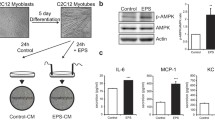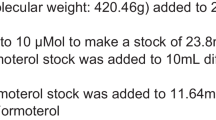Abstract
Dietary administration of orotic acid (OA), an intermediate in the pyrimidine biosynthetic pathway, is considered to provide a wide range of beneficial effects, including cardioprotection and exercise adaptation. Its mechanisms of action, when applied extracellularly, however, are barely understood. In this study, we evaluated potential effects of OA on skeletal muscle using an in vitro contraction model of electrically pulse-stimulated (EPS) C2C12 myotubes. By analyzing a subset of genes representing inflammatory, metabolic, and structural adaptation pathways, we could show that OA supplementation diminishes the EPS-provoked expression of inflammatory transcripts (interleukin 6, Il6; chemokine (C-X-C Motif) ligand 5, Cxcl5), and attenuated transcript levels of nuclear receptor subfamily 4 group A member 3 (Nr4A3), early growth response 1 (Egr1), activating transcription factor 3 (Atf3), and fast-oxidative MyHC-IIA isoform (Myh2). By contrast, OA had no suppressive effect on the pathogen-provoked inflammatory gene response in skeletal muscle cells, as demonstrated by stimulation of C2C12 myotubes with bacterial LPS. In addition, we observed a suppressive effect of OA on EPS-induced phosphorylation of AMP-activated protein kinase (AMPK), whereas EPS-triggered phosphorylation/activation of the mammalian target of rapamycin (mTOR) was not affected. Finally, we demonstrate that OA positively influences glycogen levels in EP-stimulated myotubes. Taken together, our results suggest that in skeletal muscle cells, OA modulates both the inflammatory and the metabolic reaction provoked by acute contraction. These results might have important clinical implications, specifically in cardiovascular and exercise medicine.







Similar content being viewed by others
References
Geiss KR, Stergiou N, Jester I, Neuenfeld HU, Jester HG (1998) Effects of magnesium orotate on exercise tolerance in patients with coronary heart disease. Cardiovasc Drugs Ther 12(Suppl 2):153–156
Löffler M, Carrey EA, Zameitat E (2015) Orotic acid, more than just an intermediate of pyrimidine de novo synthesis. J Genet Genomics 42:207–219
Muntean DM, Fira-Mladinescu O, Mirica NS, Duicu OM, Trancota SL, Sturza A (2010) Metabolic therapy: cardioprotective effects of orotic acid and its derivatives. Biomed Rev 21:47–55
Rai M, Demontis F (2016) Systemic nutrient and stress signaling via myokines and myometabolites. Annu Rev Physiol 78:85–107
Rosenfeldt FL (1998) Metabolic supplementation with orotic acid and magnesium orotate. Cardiovasc Drugs Ther 12(Suppl 2):147–152
Rosenfeldt FL, Richards SM, Lin Z, Pepe S, Conyers RA (1998) Mechanism of cardioprotective effect of orotic acid. Cardiovasc Drugs Ther 12(Suppl 2):159–170
Stepura OB, Martynow AI (2009) Magnesium orotate in severe congestive heart failure (MACH). Int J Cardiol 131:293–295
Evans DR, Guy HI (2004) Mammalian pyrimidine biosynthesis: fresh insights into an ancient pathway. J Biol Chem 279:33035–33038
Desler C, Lykke A, Rasmussen LJ (2010) The effect of mitochondrial dysfunction on cytosolic nucleotide metabolism. J Nucleic Acids 24:701518
Griffin JL, Bonney SA, Mann C, Hebbachi AM, Gibbons GF, Nicholson JK, Shoulders CC, Scott J (2004) An integrated reverse functional genomic and metabolic approach to understanding orotic acid-induced fatty liver. Physiol Genomics 17:140–149
Jung EJ, Kwon SW, Jung BH, Oh SH, Lee BH (2011) Role of the AMPK/SREBP-1 pathway in the development of orotic acid-induced fatty liver. J Lipid Res 52:1617–1625
Jung EJ, Lee KY, Lee BH (2012) Proliferating effect of orotic acid through mTORC1 activation mediated by negative regulation of AMPK in SK-Hep1 hepatocellular carcinoma cells. J Toxicol Sci 37:813–821
Durschlag RP, Robinson JL (1980) Species specificity in the metabolic consequences of orotic acid consumption. J Nutr 110:822–828
Donohoe JA, Rosenfeldt FL, Munsch CM, Williams JF (1993) The effect of orotic acid treatment on the energy and carbohydrate metabolism of the hypertrophying rat heart. Int J Biochem 25:163–182
Porto LC, de Castro CH, Savergnini SS, Santos SH, Ferreira AV, Cordeiro LM, Sobrinho DB, Santos RA, de Almeida AP, Botion LM (2012) Improvement of the energy supply and contractile function in normal and ischemic rat hearts by dietary orotic acid. Life Sci 90:476–483
Choi YJ, Yoon Y, Lee KY, Kang YP, Lim DK, Kwon SW, Kang KW, Lee SM, Lee BH (2015) Orotic acid induces hypertension associated with impaired endothelial nitric oxide synthesis. Toxicol Sci 144:307–317
Evers-van Gogh IJ, Alex S, Stienstra R, Brenkman AB, Kersten S, Kalkhoven E (2015) Electric pulse stimulation of myotubes as an in vitro exercise model: cell-mediated and non-cell-mediated effects. Sci Rep 5:10944
Manabe Y, Miyatake S, Takagi M, Nakamura M, Okeda A, Nakano T, Hirshman MF, Goodyear LJ, Fujii NL (2012) Characterization of an acute muscle contraction model using cultured C2C12 myotubes. PLoS ONE 7:e52592
Nieuwoudt S, Mulya A, Fealy CE, Martelli E, Dasarathy S, Naga Prasad SV, Kirwan JP (2017) In vitro contraction protects against palmitate-induced insulin resistance in C2C12 myotubes. Am J Physiol Cell Physiol 313:C575-C583
Chan FK, Moriwaki K, De Rosa MJ (2013) Detection of necrosis by release of lactate dehydrogenase activity. Methods Mol Biol 979:65–70
Fernández-Verdejo R, Vanwynsberghe AM, Essaghir A, Demoulin JB, Hai T, Deldicque L, Francaux M (2017) Activating transcription factor 3 attenuates chemokine and cytokine expression in mouse skeletal muscle after exercise and facilitates molecular adaptation to endurance training. FASEB J 31:840–851
Pearen MA, Muscat GE (2010) Minireview: nuclear hormone receptor 4A signaling: implications for metabolic disease. Mol Endocrinol 24:1891–1903
Beiter T, Hoene M, Prenzler F, Mooren FC, Steinacker JM, Weigert C, Niess AM, Munz B (2015) Exercise, skeletal muscle and inflammation: ARE-binding proteins as key regulators in inflammatory and adaptive networks. Exerc Immunol Rev 21:42–57
Pagel JI, Deindl E (2011) Early growth response 1—a transcription factor in the crossfire of signal transduction cascades. Indian J Biochem Biophys 48:226–235
Shirwany NA, Zou MH (2014) AMPK: a cellular metabolic and redox sensor. A minireview. Front Biosci 19:447–474
Nikolic N, Bakke SS, Kase ET, Rudberg I, Flo Halle I, Rustan AC, Thoresen GH, Aas V (2012) Electrical pulse stimulation of cultured human skeletal muscle cells as an in vitro model of exercise. PLoS ONE 7:e33203
Aas V, Torbla S, Andersen MH, Jensen J, Rustan AC (2002) Electrical stimulation improves insulin responses in a human skeletal muscle cell model of hyperglycemia. Ann N Y Acad Sci 967:506–515
Lai YC, Zarrinpashneh E, Jensen J (2010) Additive effect of contraction and insulin on glucose uptake and glycogen synthase in muscle with different glycogen contents. J Appl Physiol 108:1106–1115
Löffler M, Carrey EA, Zameitat E (2016) Orotate (orotic acid): an essential and versatile molecule. Nucleosides Nucleotides Nucleic Acids 35:566–577
Farmawati A, Kitajima Y, Nedachi T, Sato M, Kanzaki M, Nagatomi R (2013) Characterization of contraction-induced IL-6 up-regulation using contractile C2C12 myotubes. Endocr J 60:137–147
Nedachi T, Fujita H, Kanzaki M (2008) Contractile C2C12 myotube model for studying exercise-inducible responses in skeletal muscle. Am J Physiol Endocrinol Metab 295:E1191-E1204
Whitham M, Chan MH, Pal M, Matthews VB, Prelovsek O, Lunke S, El-Osta A, Broenneke H, Alber J, Brüning JC, Wunderlich FT, Lancaster GI, Febbraio MA (2012) Contraction-induced interleukin-6 gene transcription in skeletal muscle is regulated by c-Jun terminal kinase/activator protein-1. J Biol Chem 287:10771–10779
Burch N, Arnold AS, Item F, Summermatter S, Brochmann Santana Santos G, Christe M, Boutellier U, Toigo M, Handschin C (2010) Electric pulse stimulation of cultured murine muscle cells reproduces gene expression changes of trained mouse muscle. PLoS ONE 5:e10970
Pattamaprapanont P, Garde C, Fabre O, Barrès R (2016) Muscle contraction induces acute hydroxymethylation of the exercise-responsive gene Nr4a3. Front Endocrinol 7:165
Hoffman NJ, Parker BL, Chaudhuri R, Fisher-Wellman KH, Kleinert M, Humphrey SJ, Yang P, Holliday M, Trefely S, Fazakerley DJ, Stöckli J, Burchfield JG, Jensen TE, Jothi R, Kiens B, Wojtaszewski JF, Richter EA, James DE (2015) Global phosphoproteomic analysis of human skeletal muscle reveals a network of exercise-regulated kinases and AMPK substrates. Cell Metab 22:922–935
Catoire M, Mensink M, Boekschoten MV, Hangelbroek R, Müller M, Schrauwen P, Kersten S (2012) Pronounced effects of acute endurance exercise on gene expression in resting and exercising human skeletal muscle. PLoS ONE 7:e51066
Vissing K, Schjerling P (2014) Simplified data access on human skeletal muscle transcriptome responses to differentiated exercise. Sci Data 1:140041
Marino M, Scuderi F, Provenzano C, Bartoccioni E (2011) Skeletal muscle cells: from local inflammatory response to active immunity. Gene Ther 18:109–116
Pillon NJ, Bilan PJ, Fink LN, Klip A (2013) Cross-talk between skeletal muscle and immune cells: muscle-derived mediators and metabolic implications. Am J Physiol Endocrinol Metab 304:E453-E465
Delaney NF, Sharma R, Tadvalkar L, Clish CB, Haller RG, Mootha VK (2017) Metabolic profiles of exercise in patients with McArdle disease or mitochondrial myopathy. Proc Natl Acad Sci USA 114:8402–8407
Nielsen JN, Wojtaszewski JF, Haller RG, Hardie DG, Kemp BE, Richter EA, Vissing J (2002) Role of 5′AMP-activated protein kinase in glycogen synthase activity and glucose utilization: insights from patients with McArdle’s disease. J Physiol 541:979–989
Ha J, Guan KL, Kim J (2015) AMPK and autophagy in glucose/glycogen metabolism. Mol Aspects Med 46:46–62
Sylow L, Kleinert M, Richter EA, Jensen TE (2017) Exercise-stimulated glucose uptake- regulation and implications for glycaemic control. Nat Rev Endocrinol 13:133–148
Jensen TE, Richter EA (2012) Regulation of glucose and glycogen metabolism during and after exercise. J Physiol 590:1069–1076
Philp A, Hargreaves M, Baar K (2012) More than a store: regulatory roles for glycogen in skeletal muscle adaptation to exercise. Am J Physiol Endocrinol Metab 302:E1343-E1351
Sarma DS, Sidransky H (1969) Studies on orotic acid fatty liver in rats: factors influencing the induction of fatty liver. J Nutr 98:33–40
Ferdinandy P, Fazekas T, Kadar E (1998) Effects of orotic acid on ischaemic/reperfused myocardial function and glycogen content in isolated working rat hearts. Pharmacol Res 37:111–114
McCarthy MF, DiNicolantonio JJ (2014) β-Alanine and orotate as supplements for cardiac protection. Open Heart 1:e000119
Fork C, Bauer T, Golz S, Geerts A, Weiland J, Del Turco D, Schömig E, Gründemann D (2011) OAT2 catalyses efflux of glutamate and uptake of orotic acid. Biochem J 436:305–312
Miura D, Anzai N, Jutabha P, Chanluang S, He X, Fukutomi T, Endou H (2011) Human urate transporter 1 (hURAT1) mediates the transport of orotate. J Physiol Sci 61:253–257
Hey-Mogensen M, Goncalves RL, Orr AL, Brand MD (2014) Production of superoxide/H2O2 by dihydroorotate dehydrogenase in rat skeletal muscle mitochondria. Free Radic Biol Med 72:149–155
Acknowledgements
Work in the authors’ laboratory was furthermore supported by grants from the Monika-Kutzner-Stiftung, Berlin, Germany, and from the Else-Übelmesser-Stiftung, Tübingen, Germany.
Funding
This work was supported by a grant from Wörwag Pharma, Böblingen, Germany.
Author information
Authors and Affiliations
Corresponding author
Electronic supplementary material
Below is the link to the electronic supplementary material.
Rights and permissions
About this article
Cite this article
Beiter, T., Hudemann, J., Burgstahler, C. et al. Effects of extracellular orotic acid on acute contraction-induced adaptation patterns in C2C12 cells. Mol Cell Biochem 448, 251–263 (2018). https://doi.org/10.1007/s11010-018-3330-z
Received:
Accepted:
Published:
Issue Date:
DOI: https://doi.org/10.1007/s11010-018-3330-z




